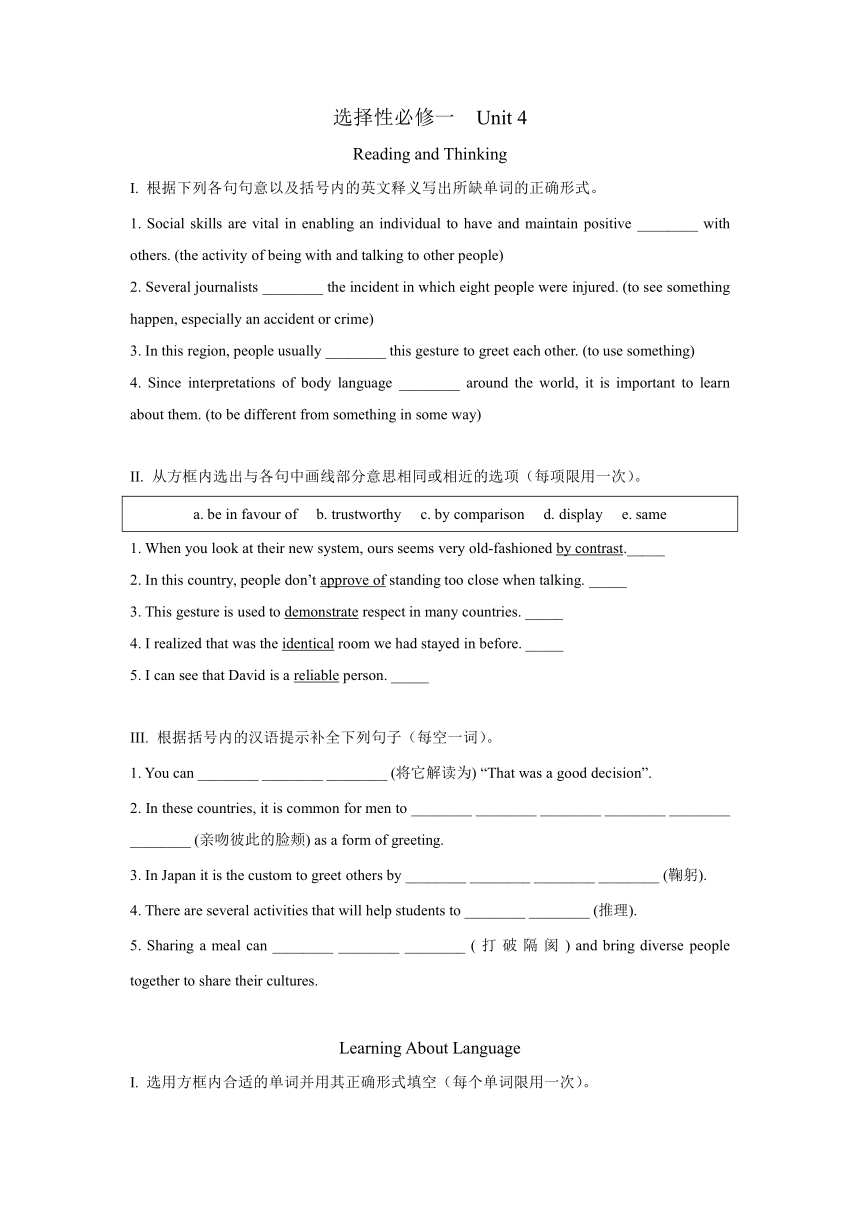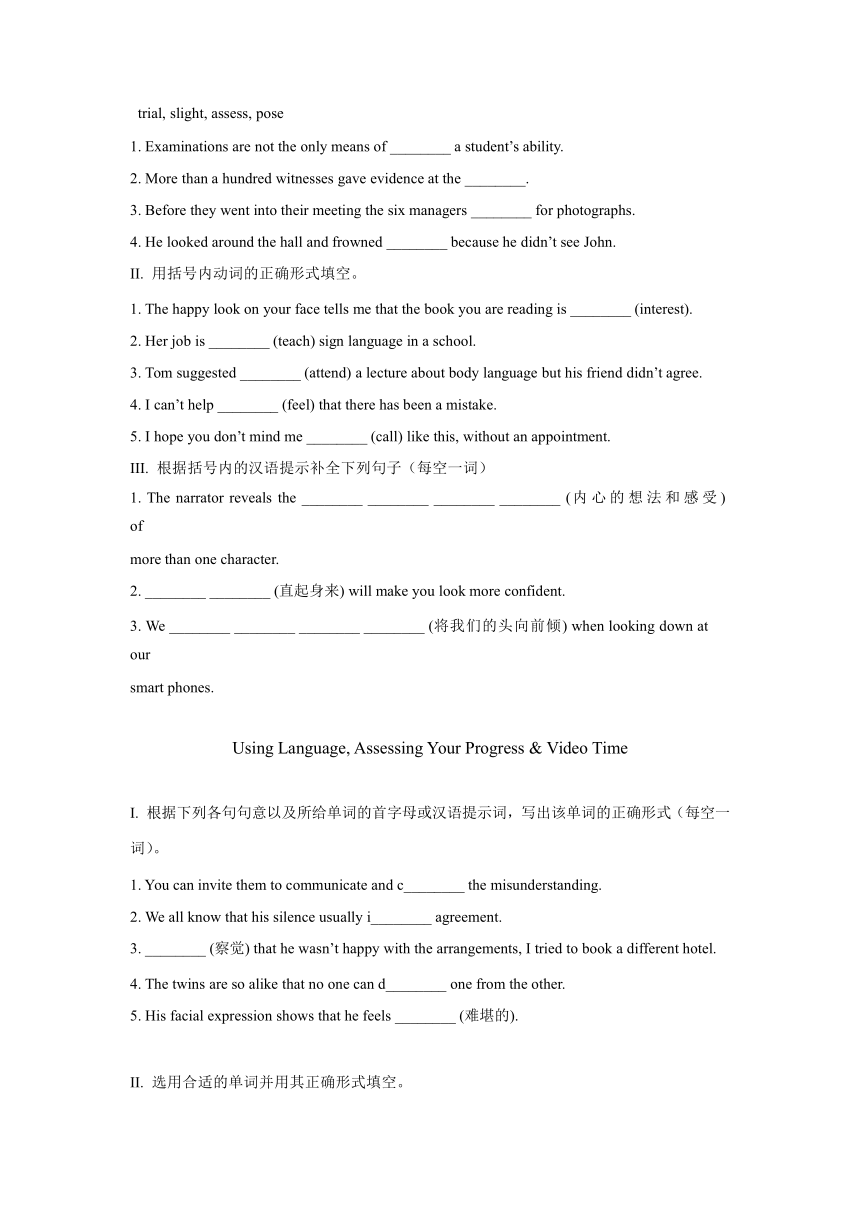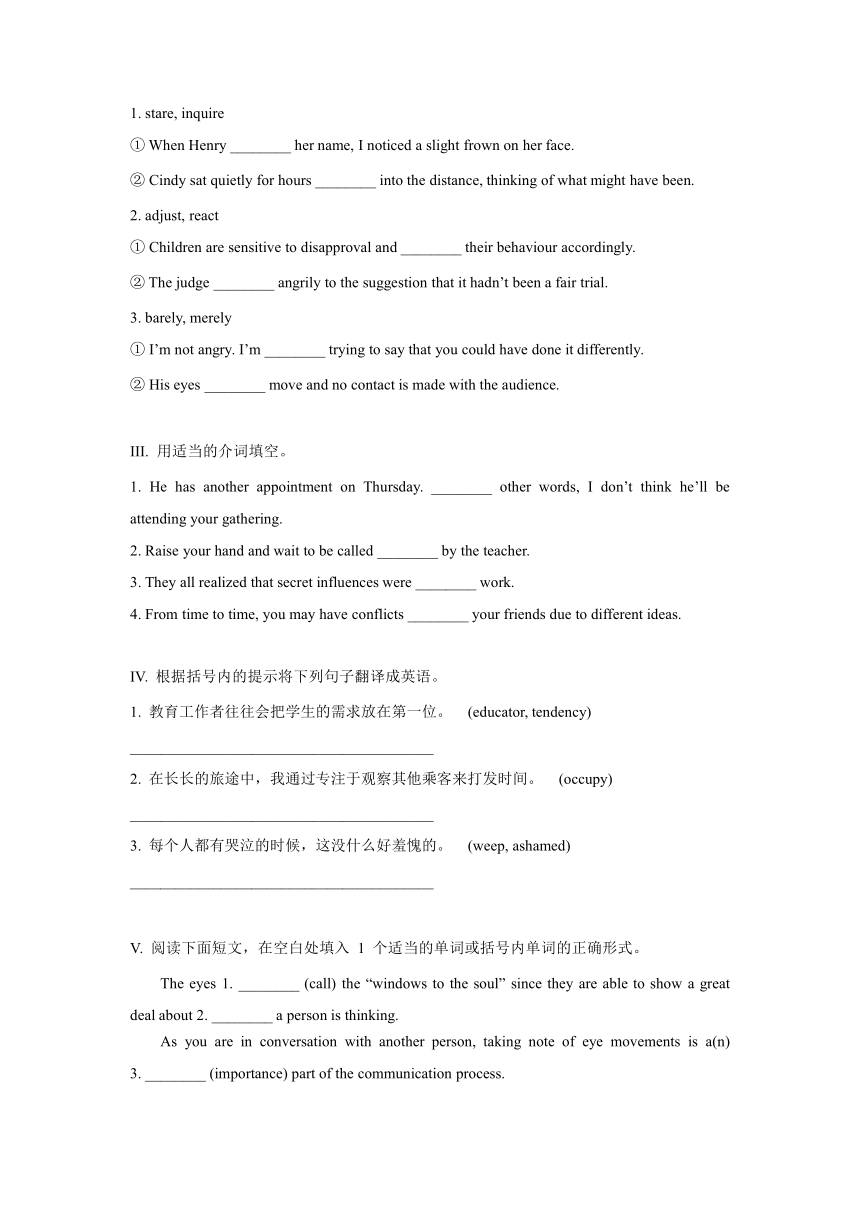人教版(2019)选择性必修第一册Unit 4 Body Language 单元测试题(含答案)
文档属性
| 名称 | 人教版(2019)选择性必修第一册Unit 4 Body Language 单元测试题(含答案) |  | |
| 格式 | docx | ||
| 文件大小 | 31.3KB | ||
| 资源类型 | 教案 | ||
| 版本资源 | 人教版(2019) | ||
| 科目 | 英语 | ||
| 更新时间 | 2022-09-21 17:28:14 | ||
图片预览



文档简介
选择性必修一 Unit 4
Reading and Thinking
I. 根据下列各句句意以及括号内的英文释义写出所缺单词的正确形式。
1. Social skills are vital in enabling an individual to have and maintain positive ________ with
others. (the activity of being with and talking to other people)
2. Several journalists ________ the incident in which eight people were injured. (to see something
happen, especially an accident or crime)
3. In this region, people usually ________ this gesture to greet each other. (to use something)
4. Since interpretations of body language ________ around the world, it is important to learn
about them. (to be different from something in some way)
II. 从方框内选出与各句中画线部分意思相同或相近的选项(每项限用一次)。
a. be in favour of b. trustworthy c. by comparison d. display e. same
1. When you look at their new system, ours seems very old-fashioned by contrast._____
2. In this country, people don’t approve of standing too close when talking. _____
3. This gesture is used to demonstrate respect in many countries. _____
4. I realized that was the identical room we had stayed in before. _____
5. I can see that David is a reliable person. _____
III. 根据括号内的汉语提示补全下列句子(每空一词)。
1. You can ________ ________ ________ (将它解读为) “That was a good decision”.
2. In these countries, it is common for men to ________ ________ ________ ________ ________
________ (亲吻彼此的脸颊) as a form of greeting.
3. In Japan it is the custom to greet others by ________ ________ ________ ________ (鞠躬).
4. There are several activities that will help students to ________ ________ (推理).
5. Sharing a meal can ________ ________ ________ ( 打 破 隔 阂 ) and bring diverse people
together to share their cultures.
Learning About Language
I. 选用方框内合适的单词并用其正确形式填空(每个单词限用一次)。
trial, slight, assess, pose
1. Examinations are not the only means of ________ a student’s ability.
2. More than a hundred witnesses gave evidence at the ________.
3. Before they went into their meeting the six managers ________ for photographs.
4. He looked around the hall and frowned ________ because he didn’t see John.
II. 用括号内动词的正确形式填空。
1. The happy look on your face tells me that the book you are reading is ________ (interest).
2. Her job is ________ (teach) sign language in a school.
3. Tom suggested ________ (attend) a lecture about body language but his friend didn’t agree.
4. I can’t help ________ (feel) that there has been a mistake.
5. I hope you don’t mind me ________ (call) like this, without an appointment.
III. 根据括号内的汉语提示补全下列句子(每空一词)
1. The narrator reveals the ________ ________ ________ ________ (内心的想法和感受) of
more than one character.
2. ________ ________ (直起身来) will make you look more confident.
3. We ________ ________ ________ ________ (将我们的头向前倾) when looking down at our
smart phones.
Using Language, Assessing Your Progress & Video Time
I. 根据下列各句句意以及所给单词的首字母或汉语提示词,写出该单词的正确形式(每空一
词)。
1. You can invite them to communicate and c________ the misunderstanding.
2. We all know that his silence usually i________ agreement.
3. ________ (察觉) that he wasn’t happy with the arrangements, I tried to book a different hotel.
4. The twins are so alike that no one can d________ one from the other.
5. His facial expression shows that he feels ________ (难堪的).
II. 选用合适的单词并用其正确形式填空。
1. stare, inquire
① When Henry ________ her name, I noticed a slight frown on her face.
② Cindy sat quietly for hours ________ into the distance, thinking of what might have been.
2. adjust, react
① Children are sensitive to disapproval and ________ their behaviour accordingly.
② The judge ________ angrily to the suggestion that it hadn’t been a fair trial.
3. barely, merely
① I’m not angry. I’m ________ trying to say that you could have done it differently.
② His eyes ________ move and no contact is made with the audience.
III. 用适当的介词填空。
1. He has another appointment on Thursday. ________ other words, I don’t think he’ll be
attending your gathering.
2. Raise your hand and wait to be called ________ by the teacher.
3. They all realized that secret influences were ________ work.
4. From time to time, you may have conflicts ________ your friends due to different ideas.
IV. 根据括号内的提示将下列句子翻译成英语。
1. 教育工作者往往会把学生的需求放在第一位。 (educator, tendency)
________________________________________
2. 在长长的旅途中,我通过专注于观察其他乘客来打发时间。 (occupy)
________________________________________
3. 每个人都有哭泣的时候,这没什么好羞愧的。 (weep, ashamed)
________________________________________
V. 阅读下面短文,在空白处填入 1 个适当的单词或括号内单词的正确形式。
The eyes 1. ________ (call) the “windows to the soul” since they are able to show a great
deal about 2. ________ a person is thinking.
As you are in conversation with another person, taking note of eye movements is a(n)
3. ________ (importance) part of the communication process.
When someone looks directly into your eyes while 4. ________ (have) a conversation, it
indicates that they are 5. ________ (interest) and paying attention. However, prolonged (长时间
的 ) eye contact can feel threatening. 6. ________ the other hand, breaking eye contact and
frequently looking away might indicate that the person is uncomfortable, or attempting
7. ________ (hide) his or her real feelings.
Blinking ( 眨 眼 睛 ) is natural, but you should also pay attention to whether a person is
blinking too much 8. ________ too little. Infrequent blinking may indicate that a person is trying
to control his or her eye movements. By contrast, people 9. ________ blink more rapidly are
usually feeling uncomfortable.
Pupil (瞳孔) size can also be a nonverbal communication signal. While light levels in the
environment control pupil dilation ( 扩 大 ), sometimes emotions can also cause some small
10. ________ (change) in pupil size. Highly dilated pupils, for example, can indicate that a person
is showing interest.
答案
Reading and Thinking
I.
1. interaction(s)
2. witnessed
3. employ
4. differ
II.
1. c
2. a
3. d
4. e
5. b
III.
1. interpret it as
2. kiss each other on the cheek
3. bowing from the waist
4. make inferences
5. break down barriers
Learning About Language
I.
1. assessing
2. trial
3. posed
4. slightly
II.
1. interesting
2. teaching / to teach
3. attending
4. feeling
5. calling
Using Language, Assessing Your Progress & Video Time
I.
1. clarify
2. implies
3. Perceiving
4. distinguish
5. embarrassed
II.
1. ① inquired
② staring
2. ① adjust
② reacted
3. ① merely
② barely
III.
1. In
2. on
3. at
4. with
IV.
1. Educators have a tendency to put students’ needs first.
2. On long journeys I passed the time by occupying myself with observing other passengers.
3. Everyone weeps sometimes; it’s nothing to be ashamed of.
V.
1. are called
2. what
3. important
4. having
5. interested
6. On
7. to hide
8. or
9. who / that
10. changes
Reading and Thinking
I. 根据下列各句句意以及括号内的英文释义写出所缺单词的正确形式。
1. Social skills are vital in enabling an individual to have and maintain positive ________ with
others. (the activity of being with and talking to other people)
2. Several journalists ________ the incident in which eight people were injured. (to see something
happen, especially an accident or crime)
3. In this region, people usually ________ this gesture to greet each other. (to use something)
4. Since interpretations of body language ________ around the world, it is important to learn
about them. (to be different from something in some way)
II. 从方框内选出与各句中画线部分意思相同或相近的选项(每项限用一次)。
a. be in favour of b. trustworthy c. by comparison d. display e. same
1. When you look at their new system, ours seems very old-fashioned by contrast._____
2. In this country, people don’t approve of standing too close when talking. _____
3. This gesture is used to demonstrate respect in many countries. _____
4. I realized that was the identical room we had stayed in before. _____
5. I can see that David is a reliable person. _____
III. 根据括号内的汉语提示补全下列句子(每空一词)。
1. You can ________ ________ ________ (将它解读为) “That was a good decision”.
2. In these countries, it is common for men to ________ ________ ________ ________ ________
________ (亲吻彼此的脸颊) as a form of greeting.
3. In Japan it is the custom to greet others by ________ ________ ________ ________ (鞠躬).
4. There are several activities that will help students to ________ ________ (推理).
5. Sharing a meal can ________ ________ ________ ( 打 破 隔 阂 ) and bring diverse people
together to share their cultures.
Learning About Language
I. 选用方框内合适的单词并用其正确形式填空(每个单词限用一次)。
trial, slight, assess, pose
1. Examinations are not the only means of ________ a student’s ability.
2. More than a hundred witnesses gave evidence at the ________.
3. Before they went into their meeting the six managers ________ for photographs.
4. He looked around the hall and frowned ________ because he didn’t see John.
II. 用括号内动词的正确形式填空。
1. The happy look on your face tells me that the book you are reading is ________ (interest).
2. Her job is ________ (teach) sign language in a school.
3. Tom suggested ________ (attend) a lecture about body language but his friend didn’t agree.
4. I can’t help ________ (feel) that there has been a mistake.
5. I hope you don’t mind me ________ (call) like this, without an appointment.
III. 根据括号内的汉语提示补全下列句子(每空一词)
1. The narrator reveals the ________ ________ ________ ________ (内心的想法和感受) of
more than one character.
2. ________ ________ (直起身来) will make you look more confident.
3. We ________ ________ ________ ________ (将我们的头向前倾) when looking down at our
smart phones.
Using Language, Assessing Your Progress & Video Time
I. 根据下列各句句意以及所给单词的首字母或汉语提示词,写出该单词的正确形式(每空一
词)。
1. You can invite them to communicate and c________ the misunderstanding.
2. We all know that his silence usually i________ agreement.
3. ________ (察觉) that he wasn’t happy with the arrangements, I tried to book a different hotel.
4. The twins are so alike that no one can d________ one from the other.
5. His facial expression shows that he feels ________ (难堪的).
II. 选用合适的单词并用其正确形式填空。
1. stare, inquire
① When Henry ________ her name, I noticed a slight frown on her face.
② Cindy sat quietly for hours ________ into the distance, thinking of what might have been.
2. adjust, react
① Children are sensitive to disapproval and ________ their behaviour accordingly.
② The judge ________ angrily to the suggestion that it hadn’t been a fair trial.
3. barely, merely
① I’m not angry. I’m ________ trying to say that you could have done it differently.
② His eyes ________ move and no contact is made with the audience.
III. 用适当的介词填空。
1. He has another appointment on Thursday. ________ other words, I don’t think he’ll be
attending your gathering.
2. Raise your hand and wait to be called ________ by the teacher.
3. They all realized that secret influences were ________ work.
4. From time to time, you may have conflicts ________ your friends due to different ideas.
IV. 根据括号内的提示将下列句子翻译成英语。
1. 教育工作者往往会把学生的需求放在第一位。 (educator, tendency)
________________________________________
2. 在长长的旅途中,我通过专注于观察其他乘客来打发时间。 (occupy)
________________________________________
3. 每个人都有哭泣的时候,这没什么好羞愧的。 (weep, ashamed)
________________________________________
V. 阅读下面短文,在空白处填入 1 个适当的单词或括号内单词的正确形式。
The eyes 1. ________ (call) the “windows to the soul” since they are able to show a great
deal about 2. ________ a person is thinking.
As you are in conversation with another person, taking note of eye movements is a(n)
3. ________ (importance) part of the communication process.
When someone looks directly into your eyes while 4. ________ (have) a conversation, it
indicates that they are 5. ________ (interest) and paying attention. However, prolonged (长时间
的 ) eye contact can feel threatening. 6. ________ the other hand, breaking eye contact and
frequently looking away might indicate that the person is uncomfortable, or attempting
7. ________ (hide) his or her real feelings.
Blinking ( 眨 眼 睛 ) is natural, but you should also pay attention to whether a person is
blinking too much 8. ________ too little. Infrequent blinking may indicate that a person is trying
to control his or her eye movements. By contrast, people 9. ________ blink more rapidly are
usually feeling uncomfortable.
Pupil (瞳孔) size can also be a nonverbal communication signal. While light levels in the
environment control pupil dilation ( 扩 大 ), sometimes emotions can also cause some small
10. ________ (change) in pupil size. Highly dilated pupils, for example, can indicate that a person
is showing interest.
答案
Reading and Thinking
I.
1. interaction(s)
2. witnessed
3. employ
4. differ
II.
1. c
2. a
3. d
4. e
5. b
III.
1. interpret it as
2. kiss each other on the cheek
3. bowing from the waist
4. make inferences
5. break down barriers
Learning About Language
I.
1. assessing
2. trial
3. posed
4. slightly
II.
1. interesting
2. teaching / to teach
3. attending
4. feeling
5. calling
Using Language, Assessing Your Progress & Video Time
I.
1. clarify
2. implies
3. Perceiving
4. distinguish
5. embarrassed
II.
1. ① inquired
② staring
2. ① adjust
② reacted
3. ① merely
② barely
III.
1. In
2. on
3. at
4. with
IV.
1. Educators have a tendency to put students’ needs first.
2. On long journeys I passed the time by occupying myself with observing other passengers.
3. Everyone weeps sometimes; it’s nothing to be ashamed of.
V.
1. are called
2. what
3. important
4. having
5. interested
6. On
7. to hide
8. or
9. who / that
10. changes
